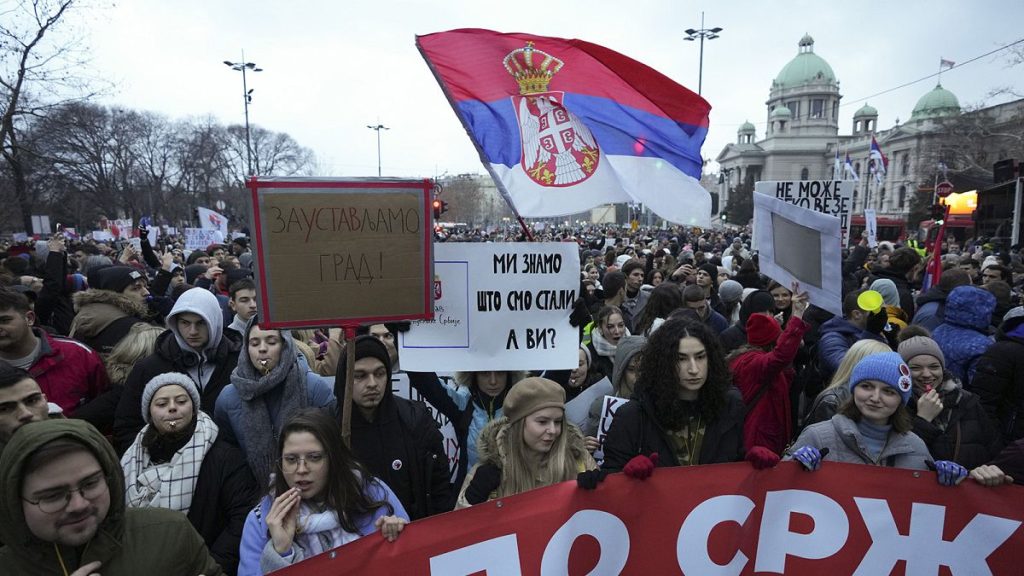The political landscape of Serbia is currently embroiled in a tense standoff between the government of President Aleksandar Vučić and a burgeoning student-led protest movement. The protests, sparked by a confluence of issues including concerns over eroding civil liberties, allegations of rampant corruption, and the tragic collapse of a train station awning in Novi Sad, have drawn tens of thousands of participants and pose a significant challenge to Vučić’s authority. The incident in Novi Sad, where a concrete awning collapsed, tragically highlighting what many perceive as systemic negligence and corruption in public works projects, has become a potent symbol of the protesters’ grievances. Adding fuel to the fire, a recent incident involving a student protester being struck by a car during a demonstration has further intensified the protests and solidified the students’ resolve.
The protests are characterized by a palpable sense of frustration and disillusionment among Serbian youth, who feel their voices are being ignored and their future jeopardized by the government’s policies. The students’ demands encompass a broad spectrum of concerns, from calls for greater transparency and accountability in government dealings to demands for a more robust protection of civil liberties and an end to what they perceive as a creeping authoritarianism under Vučić’s leadership. The government’s response has been largely dismissive, with Vučić accusing the protesters of being manipulated by foreign influences and labeling them as “stupid” and out of touch with reality. This dismissive rhetoric, coupled with reports of harassment and intimidation of protesters, has only served to deepen the divide between the government and the protesting students.
The incident where a student protester was struck by a car during a demonstration has become a focal point of the ongoing conflict. Footage of the incident, widely circulated on social media, shows the young woman being carried on the hood of a car as it drives through the crowd, before tumbling off as the vehicle speeds away. The driver has since been apprehended, and the injured student hospitalized. This incident has galvanized the protest movement, prompting calls for a “total blockade” and further intensifying the confrontation with the government. It underscores the escalating tensions and the potential for further clashes between protesters and authorities.
The government’s response to the protests has been marked by a combination of dismissiveness and accusations of foreign interference. Vučić has accused the protesters of being pawns of Western interests, suggesting they are being financially supported to destabilize the country. Pro-government media outlets have also published personal information of some protesters, a move that has raised concerns about potential involvement of the country’s security services in targeting and intimidating the demonstrators. These tactics, however, appear to have backfired, further fueling public support for the students and solidifying the perception of the government as being out of touch with the concerns of its citizens.
Despite the government’s attempts to downplay and discredit the protests, the movement continues to gain momentum, attracting a diverse cross-section of Serbian society. The students have garnered significant public support, with many citizens echoing their concerns about corruption, declining civil liberties, and the government’s perceived authoritarian tendencies. The rallies continue to draw large crowds, indicating a growing dissatisfaction with the status quo and a desire for meaningful change. The students’ persistence in the face of government pressure and intimidation speaks to the depth of their commitment and the urgency of their demands.
The ongoing protests in Serbia represent a significant challenge to Aleksandar Vučić’s government and underscore a growing discontent within the country. The students’ demands for greater transparency, accountability, and protection of civil liberties resonate with a wider public increasingly concerned about the direction of the country under Vučić’s leadership. The government’s dismissive response and accusations of foreign interference have only served to exacerbate the situation, further polarizing public opinion and solidifying the protesters’ resolve. The incident involving the injured student protester has become a rallying cry for the movement, highlighting the escalating tensions and the potential for further confrontation. As the protests continue to gain momentum, the future of Serbia’s political landscape remains uncertain, with the outcome of this standoff between the government and its citizens hanging in the balance.














